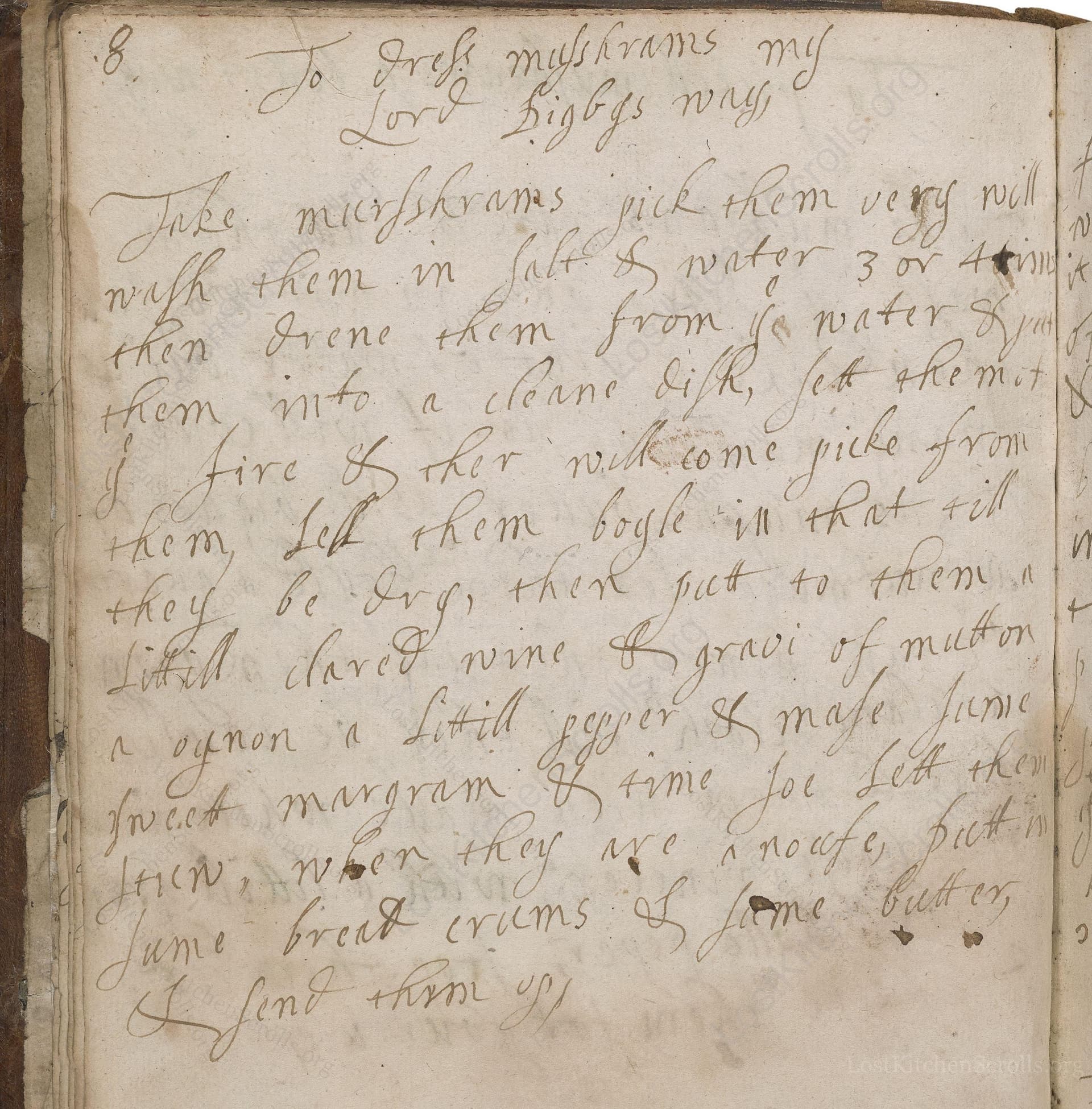To Dress Mushrooms My Lord Digbys Way
From the treasured pages of The Lady Grace Castleton's booke of receipts
Written by Grace Saunderson, Viscountess Castleton

To Dress Mushrooms My Lord Digbys Way
"Take mushrooms pick them very well wash them in salt & water 3 or 4 times then drene them from the water & put them into a cleane dish, sett them on ye fire & ther will come picke from them Lett them boyle in that till they be dry, then put to them a littell claret wine & gravi of mutton a oynon a littill pepper & mase sume sweet margram & time soe lett them stew, when they are a noufe, put in sume bread crums & sume butterr, & send them up"
Note on the Original Text
The recipe is written as a continuous instruction, blending method and ingredient list into a single paragraph—a common trait of early modern recipes. Measurements are either unspecified or very imprecise, as cooks relied heavily on experience and judgement rather than strict quantities. Spelling is typical of the 17th-century English ('oynon' for onion, 'boyle' for boil, 'margram' for marjoram, 'mas' for mace), reflecting the lack of standardized English orthography at the time. This gives the recipe a charming, rustic air but also requires contextual interpretation for the modern cook.

Title
The Lady Grace Castleton's booke of receipts (1650)
You can also click the book image above to peruse the original tome
Writer
Grace Saunderson, Viscountess Castleton
Era
1650
Publisher
Unknown
Background
A delightful voyage into 17th-century English kitchens, this collection reveals the refined tastes and culinary secrets of the aristocracy, serving up a sumptuous array of period recipes and gracious domestic wisdom.
Kindly made available by
Folger Shakespeare Library
This recipe comes from the 17th-century recipe collection of Grace Saunderson, Viscountess Castleton, who lived during the 1600s. It is attributed to Lord Digby, likely reflecting the culinary preferences of English aristocracy at the time. In the era before refrigeration, mushrooms were prized for their earthy flavor and brief season, making them a delicacy. Cooking techniques relied on simple seasonings and accessible meats—here, mutton gravy—showcasing both resourcefulness and the influence of imported flavors (like claret wine).

Prepared with basic kitchen tools of the period: a knife for preparing mushrooms and onions, a large bowl or basin for washing, a strainer or cloth for draining, and a heavy-bottomed pot or pan for cooking over an open fire or hearth. A wooden spoon was likely used for stirring, with coarse, homemade breadcrumbs made from stale bread added at the end for texture and thickening.
Prep Time
15 mins
Cook Time
25 mins
Servings
2
We've done our best to adapt this historical recipe for modern kitchens, but some details may still need refinement. We warmly welcome feedback from fellow cooks and culinary historians — your insights support the entire community!
Ingredients
- 14oz fresh mushrooms (button or cremini)
- 4 cups water with 1 tablespoon salt (for washing)
- 3 tablespoons dry red wine (substitute for claret)
- 3 tablespoons mutton or lamb stock (beef stock if unavailable)
- 1 small onion, sliced
- Pinch of ground black pepper
- 1 small blade of mace (or 1/8 tsp ground mace)
- Pinch of dried marjoram
- Pinch of dried thyme
- 1 ounce fresh breadcrumbs
- 1.5 tablespoons unsalted butter
Instructions
- Begin by thoroughly cleaning 14oz of fresh mushrooms—button or cremini work well—by washing them in salted water three to four times, then draining them well.
- Place the mushrooms in a clean saucepan and cook them gently over medium heat.
- As they heat, liquid (or 'pickle') will release; simmer the mushrooms in their own juices until most of the moisture evaporates and they look fairly dry.
- Next, add about 3 tablespoons of dry red wine (a modern substitute for claret), 3 tablespoons of good-quality lamb or mutton stock, one small onion (sliced), a pinch of ground black pepper, a small blade of mace, a pinch of dried marjoram, and a pinch of dried thyme.
- Let the mushrooms simmer gently for 15 minutes to allow the flavors to blend and the sauce to reduce slightly.
- When the mushrooms are cooked and the sauce is nicely thickened, stir in about 1 ounce of fresh breadcrumbs and 1.5 tablespoons of unsalted butter to finish the dish.
- Serve hot as a savory side or part of a main course.
Estimated Calories
210 per serving
Cooking Estimates
You will need about 15 minutes to wash and slice the mushrooms and onion, and prepare the other ingredients. Cooking the mushrooms and simmering them with the wine and stock takes around 25 minutes. This recipe makes about 2 good-sized servings, each with approximately 210 calories.
As noted above, we have made our best effort to translate and adapt this historical recipe for modern kitchens, taking into account ingredients nowadays, cooking techniques, measurements, and so on. However, historical recipes often contain assumptions that require interpretation.
We'd love for anyone to help improve these adaptations. Community contributions are highly welcome. If you have suggestions, corrections, or cooking tips based on your experience with this recipe, please share them below.
Join the Discussion
Rate This Recipe
Dietary Preference
Main Ingredients
Occasions

Den Bockfisch In Einer Fleisch Suppen Zu Kochen
This recipe hails from a German manuscript cookbook compiled in 1696, a time whe...

Die Grieß Nudlen Zumachen
This recipe comes from a rather mysterious manuscript cookbook, penned anonymous...

Ein Boudain
This recipe comes from an anonymous German-language manuscript cookbook from 169...

Ein Gesaltzen Citroni
This recipe, dating from 1696, comes from an extensive anonymous German cookbook...
Browse our complete collection of time-honored recipes



